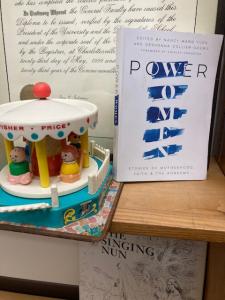In 2005 some visitors to a German museum accidentally found themselves in an exhibit called “Crown and Veil,” a dazzling collection of art and artifacts from women’s monastic houses. Perhaps guessing the title would hold out to them something glamorous and familiar—princesses? wedding dresses?—the guests expressed their dismay upon discovering what it held: “Oh dear, it’s nuns.”
An intriguing, if embarrassing, combination of attitudes often greets mention of women religious: flat uninterest, discomfiture, lurid curiousity. Nuns figure significantly in the history of Europe, the United States, and beyond. For centuries nuns have prayed, lived in community, patronized art, pursued scholarship. While general audiences may be less receptive, academics have become avid students of sisters, publishing scores of fine books in the last several decades. In the current issue of Books and Culture, I discuss two of these in a review, “Saints and Sisters.” The European settings of the two books, Crown and Veil (in which the museum visit narrated above appears) and Dominican Women and Renaissance Art, make the centrality of women’s orders apparent. Even now tourists in European cities cannot help but mark the (omni)presence of old convents.
In the United States the impact of Catholic sisters may be less visible. Focus on Protestant Christianity can foster neglect of female monasticism—or worse. Given the persistence of anti-Catholicism, convents sometimes get scandalous attention instead, as in tell-alls of wicked women behind the walls, like the infamous nineteenth-century confessions of Maria Monk.
A new book by Margaret M. McGuinness, Called to Serve: A History of Nuns in America, brings forth accounts of religious commitment and heroic service. American sisters staffed hospitals, taught in schools, and served alongside waves of immigrants and settlers moving west. The story merits attention on several fronts. Religious women participated in the events that fill standard narratives of America. They also present a distinct model for women in work and leadership. Historically, religious life offered women the single acceptable alternate path to marriage and motherhood. Though convents imposed strictures and privations that may appear unattractive to our sensibilities, they also afforded the prospect of study, contemplation, and community life to women when no other institution did so.
Though their numbers have dwindled, nuns in America continue to do important and sometimes controversial work. Pope Francis has reaffirmed his predecessor’s concerns about feminism and social activism among American nuns, represented in the Leadership Conference of Women Religious. The illustrious history of American sisters makes this a dialogue worth following.












